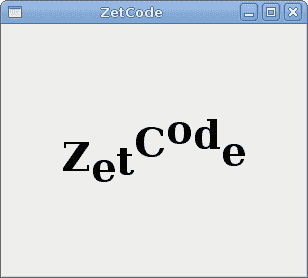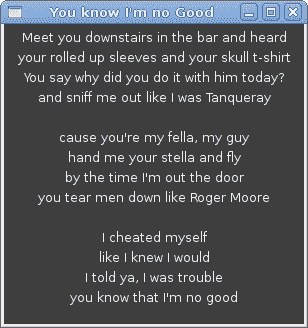Pango II
在 PyGTK 编程教程的这一部分中,我们将继续探索 Pango 库。
动画文字
下面的示例在窗口上显示动画文本。
animation.py
#!/usr/bin/python
# ZetCode PyGTK tutorial
#
# This example shows animated text
#
# author: jan bodnar
# website: zetcode.com
# last edited: February 2009
import gtk
import glib
import pango
import math
class PyApp(gtk.Window):
def __init__(self):
super(PyApp, self).__init__()
self.connect("destroy", gtk.main_quit)
glib.timeout_add(160, self.on_timer)
self.count = 1
self.set_border_width(10)
self.set_title("ZetCode")
self.label = gtk.Label("ZetCode")
fontdesc = pango.FontDescription("Serif Bold 30")
self.label.modify_font(fontdesc)
vbox = gtk.VBox(False, 0)
vbox.add(self.label)
self.add(vbox)
self.set_size_request(300, 250)
self.set_position(gtk.WIN_POS_CENTER)
self.show_all()
def on_timer(self):
attr = pango.AttrList()
self.count = self.count + 1
for i in range(7):
r = pango.AttrRise(int(math.sin(self.count+i)*20)*pango.SCALE, i, i+1)
attr.insert(r)
self.label.set_attributes(attr)
return True
PyApp()
gtk.main()
在上面的代码示例中,标签小部件中有一个文本。 通过不断更改其 pango 属性,可以对文本进行动画处理。
self.label = gtk.Label("ZetCode")
fontdesc = pango.FontDescription("Serif Bold 30")
self.label.modify_font(fontdesc)
我们创建标签小部件并修改其字体。 我们选择较大的文本以提高可见性。
vbox = gtk.VBox(False, 0)
vbox.add(self.label)
我们将标签放入垂直框中。 这将标签居中在窗口上。
动画在on_timer()方法内部执行。
for i in range(7):
r = pango.AttrRise(int(math.sin(self.count+i)*20)*pango.SCALE, i, i+1)
attr.insert(r)
我们的文字中有七个字符。 我们会定期更改每个角色的 pango AttrRise属性。 上升基于三角正弦函数。 文本移动遵循在笛卡尔图上绘制的正弦函数。
另请注意pango.SCALE常数。 Pango 库有自己的单元。 它们与小部件用来绘制图形或文本的方式不同。 我们必须用这个常数乘数字。

图:动画文本
使用标记语言
我们可以使用内置的标记语言来更改文本的属性。
markup.py
#!/usr/bin/python
# ZetCode PyGTK tutorial
#
# This example uses markup language
# to change attributes of the text
#
# author: jan bodnar
# website: zetcode.com
# last edited: February 2009
import gtk
import pango
quote = "<span foreground='blue' size='19000'>The only victory over love is flight</span>"
class PyApp(gtk.Window):
def __init__(self):
super(PyApp, self).__init__()
self.set_title("Markup")
self.set_border_width(5)
self.connect("destroy", gtk.main_quit)
label = gtk.Label()
label.set_markup(quote)
vbox = gtk.VBox(False, 0)
vbox.add(label)
self.add(vbox)
self.set_position(gtk.WIN_POS_CENTER)
self.show_all()
PyApp()
gtk.main()
在代码示例中,我们有一个标签。 我们使用标记语言更改其文本属性。
quote = "<span foreground='blue' size='19000'>The only victory over love is flight</span>"
这是带有标记语言的文本。
label = gtk.Label()
label.set_markup(quote)
我们创建标签小部件并为其设置标记文本。

图:使用标记
Pango 布局
Pango 布局是一个对象,代表带有属性的文本段落。
layout.py
#!/usr/bin/python
# ZetCode PyGTK tutorial
#
# This example shows pango Layout
# in action
#
# author: jan bodnar
# website: zetcode.com
# last edited: February 2009
import gtk
import pango
lyrics = """Meet you downstairs in the bar and heard
your rolled up sleeves and your skull t-shirt
You say why did you do it with him today?
and sniff me out like I was Tanqueray
cause you're my fella, my guy
hand me your stella and fly
by the time I'm out the door
you tear men down like Roger Moore
I cheated myself
like I knew I would
I told ya, I was trouble
you know that I'm no good"""
class Area(gtk.DrawingArea):
def __init__(self):
super(Area, self).__init__()
self.modify_bg(gtk.STATE_NORMAL, gtk.gdk.Color(16400, 16400, 16440))
self.connect("expose_event", self.expose)
def expose(self, widget, event):
gc = self.get_style().fg_gc[gtk.STATE_NORMAL]
font_desc = pango.FontDescription('Sans 10')
layout = self.create_pango_layout(lyrics)
width, height = self.get_size_request()
attr = pango.AttrList()
fg_color = pango.AttrForeground(60535, 60535, 60535, 0, -1)
attr.insert(fg_color)
layout.set_width(pango.SCALE * self.allocation.width)
layout.set_spacing(pango.SCALE * 3)
layout.set_alignment(pango.ALIGN_CENTER)
layout.set_font_description(font_desc)
layout.set_attributes(attr)
self.window.draw_layout(gc, 0, 5, layout)
class PyApp(gtk.Window):
def __init__(self):
super(PyApp, self).__init__()
self.connect("destroy", gtk.main_quit)
self.set_title("You know I'm no Good")
self.add(Area())
self.set_size_request(300, 300)
self.set_position(gtk.WIN_POS_CENTER)
self.show_all()
PyApp()
gtk.main()
在前面的示例中,我们正在修改现有小部件中的文本。 现在,我们将使用DrawingArea小部件上的 pango 布局绘制文本。 我们将使用Gdk绘图工具进行绘图。
gc = self.get_style().fg_gc[gtk.STATE_NORMAL]
我们得到了绘图区域小部件的图形顶点。
layout = self.create_pango_layout(lyrics)
在这里创建 pango 布局对象。
layout.set_width(pango.SCALE * self.allocation.width)
layout.set_spacing(pango.SCALE * 3)
layout.set_alignment(pango.ALIGN_CENTER)
layout.set_font_description(font_desc)
layout.set_attributes(attr)
我们修改布局的宽度,间距,对齐方式,字体并设置文本属性。
self.window.draw_layout(gc, 0, 5, layout)
布局正在窗口上绘制。

图:布局
在 PyGTK 编程库的这一章中,我们进一步使用了 pango 库。

